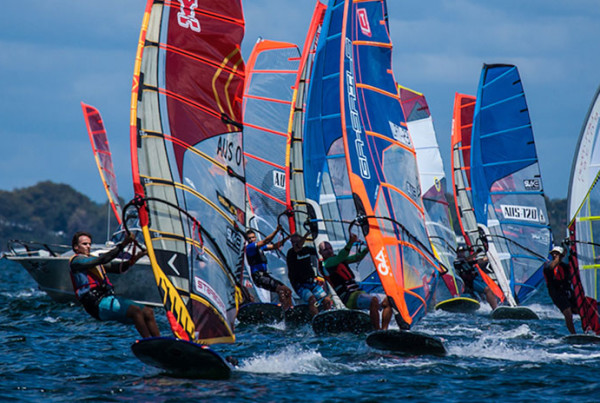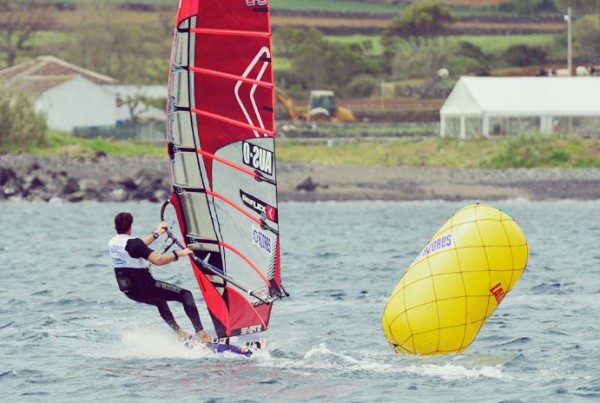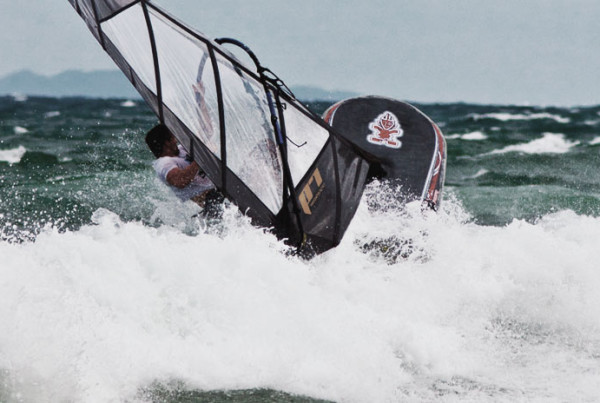It all started with a post on the Star-Board forum about sailors having difficulty getting their new Starboard F161 formula boards over the 30 knot mark. From there, sailors from around the world reignited their interest in achieving the fastest speed on the gps-speedsurfing formula rankings. Being present at the beach where Dennis Littel posted his record of 34.04 knots (peak) we discovered some new ideas on tuning formula kit for high downwind speeds and also how this knowledge could be applied on the race course to improve your downwind speed.
It has long been said that the best setup for sailing formula (FW) kit at its top speed potential is to have:
- tiny sail
- tiny fin
- dead flat water
- lots of wind
- balls of steel!
Here is the original post on the Starboard Forum where some people have suggested this setup (and where all the hype began) and another from the Seabreeze Forum in Australia:
This article is to show you that a lot of that information is incorrect and can actually prevent you from reaching your top speed on your FW kit. To understand how to go fast downwind we must look at the basics first…
Angles and Blades of Glory:
The fastest angle appears to be around 120 degrees. FW boards can obviously run much deeper angles than that (up to 150 degrees) but you generally travel slower when heading very deep. When you do head deeper than 120 degrees, your apparent wind decreases appreciably (almost below your board speed) which counteracts the ability to travel faster – as your board cannot go faster than your apparent wind.
FW boards are wide and have a lot of wetted surface area. The main aim in improving your downwind speed is reducing your wetted surface area. This is usually done by railing the board with your feet (and stance on the board), but selecting the correct fin can make railing even easier downwind. To go fast at 120 degrees, you require a decent sized FW fin of no less than 66cm. Shorter fins (especially now that the tail width on most modern formula boards is +82cm) will make the board unstable and most likely give you spin-out problems.
Use a Bigger Sail:
To go faster downwind, you usually would take a bigger sail out on the racecourse. Most people understand this as the increase in power with a larger sail is the sole cause of the increase in downwind speed. A larger sail (and more power) helps considerably to rail the board downwind which also results in downwind speed increase. The faster you go, the more drag you have and power you need, so to help reduce the drag – use a sail that helps you rail the board downwind and reduce the board’s drag.
Generally speaking, FW speed records will be most likely set in +25 knot winds so most sailors will be already down on their smaller rigs. It is my opinion that 9m sails will be difficult to achieve speeds over 30 knots with and those who have achieved this feat would have been faster on 10m sails. A 10m/11m sail will generate the required power to help rail the board, provided the fin is compatible and also working with the overall tuning of the equipment.
So in actual fact, the conditions needed for a super fast FW speed should be:
- powerful sail (10m/11m recommended)
- small fin (+66cm at least, but powerful enough to help rail the board)
- lot’s of wind (+25 knots mandatory)
- relatively flat water with small, close together chop (we’ll get to this in a minute)
- balls of steel!
Flying The Fin:
 This is by far the fastest way to travel downwind. By “flying the fin” you are railing the board so excessively that at times there is only a small portion of the leeward rail in the water. Have a look at this fantastic photo of Danish sailor Jesper Vesterstrom (DEN-111) taken by John Carter in England. Jesper is using an 11.8m sail and 70cm fin in 15-18 knots of wind in this photo and he is able to comfortably rail the board to reduce the drag it produces through the water.
This is by far the fastest way to travel downwind. By “flying the fin” you are railing the board so excessively that at times there is only a small portion of the leeward rail in the water. Have a look at this fantastic photo of Danish sailor Jesper Vesterstrom (DEN-111) taken by John Carter in England. Jesper is using an 11.8m sail and 70cm fin in 15-18 knots of wind in this photo and he is able to comfortably rail the board to reduce the drag it produces through the water.
This is achieved mostly by pointing your toes and using your front foot to pull up on the strap to iniate the railing. A tighter back strap will help with this also, however most FW sailors run a slightly looser back footstrap to allow their foot to step in closer to the middle of the board and not so far out onto the rail. It is important to have a stance on the board that keeps the sail upright and allows the sail to breath so as to keep control of the board as it goes through the chop on the rail.
Chop, Not Flat:
Believe it or not, small chop helps your FW speed by increases the board’s ability to rail downwind. On a speed strip, with ultra flat water it is more difficult to rail the board and keep it railed. Dennis Littel commented after his famous day that his fastest runs were in the small 20-40cm chop away from the smooth bank he had been running along. The board would be easier railed, which allowed the sailor to concentrate on his stance and sheeting, to keep the board trimmed and fluent through the water.
The closer the chop is together, the more this will help. In strong winds this may be a dangerous combination for some – but you have already signed your life away by wanting to get a FW board over 30 knots !!
Some More Stats:
Here is a link to Dennis Littel’s famous record breaking run and also my run on the same day at the same location. My setup was: Starboard F161, Gaastra Vapor 10m, R13 66cm M. Dennis used F2 FX-V, MauiSails TR-3 11m, R13 68cm.
- http://www.aus120.com/gps/ (AUS-120, unedited track)
- http://www.gps-speedsurfing.com (NED-13, record details)
Unfortunately, I did not sail enough runs that day to get my average up over 30 knots, although my top speed was over 32 knots. Both of us were running our “racing” setup and did not modify the trim in any way for the speed runs. In fact, that gear was capable of doing <49 degree angles upwind at 15 knots boardspeed with VMG’s of over 10 knots.
The fastest sailors downwind on the race course can usually translate that ability to being fast on the speed course. It is a combination of equipment, technique and conditions however I believe the first two play a far more important role on an FW board than on a speed needle.
Hopefully this article spurs more people on to brave the craziness that is high-speed FW sailing!









